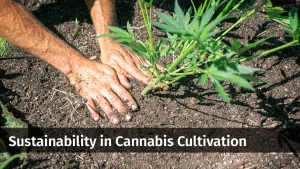 (This is the seventh installment in a series examining sustainability in cannabis cultivation. Read Part 6 here.)
(This is the seventh installment in a series examining sustainability in cannabis cultivation. Read Part 6 here.)
Cover crops can help cannabis growers use less water and fewer added nutrients as well as reduce overall costs tied to things such as soil replacement or pesticides.
Cover plants, which include clover, mustard and cereal grains such as rye and oats, are often incorporated as part of a living-soil cultivation system – where the planting material is rich with microorganisms that feed the cannabis plants versus synthetic nutrients.
The cover crop can be grown along with the cannabis plants to help fend off harmful predatory bugs, for example.
Or the plants can be deployed during the offseason, when the soil is fallow, to prevent erosion.
Using cover crops in a living-soil system is a much more sustainable and economically viable way of growing cannabis than traditional methods, said Josh Turner, vice president of cultivation for Southbridge, Massachusetts-based Green Meadows, a vertically integrated marijuana company.
“It produces a high-quality and clean product,” he added. “Without the cover crop, you’re not fully taking advantage of the living-soil system.”
Cover crops to prevent pests
At Green Meadows, Turner uses cover crops with a living-soil system in raised beds in an indoor grow.
“We’re trying to replicate the soil-food web in an indoor environment,” he said. “If you’re doing large, raised beds and you have a large living-soil buffer, I think it’s absolutely critical to have a cover crop.”
Green Meadows uses its cover crops as part of the company’s integrated pest-management system.
Some of the natural terpenoids in the cover crops deter bugs, according to Turner.
For example, mustard is good for keeping away predatory insects, he said.
On the flip side, Turner will use marigolds, for example, as a “banker plant” to house beneficial insects such as predatory mites that feed on harmful insects, including spider mites.
His team is also researching what cover crops lure away other bad bugs such as thrips or aphids.
Turner uses cover crops in three other ways:
- Rye, oat and wheat help build up biomass and break up soil compaction. Plants that aerate the soil lead to a better distribution of water.
- Legumes, including peas, clover and vetch, fix nitrogen in the soil that the cannabis plants can take up.
- Broadleaves such as buckwheat and alyssum are quick germinators that protect the soil and suppress weeds.
When it comes to cost, Turner believes that cover crops save a grower money in the long run because there is less need to add nitrogen back to the soil, the cannabis requires less water and predatory insects don’t need to be added every harvest.
Soil protection during offseason
For Lauren Fortier, director of cultivation at Theory Wellness, a marijuana company based in Stoneham, Massachusetts, cover crops are planted when cannabis is not in the ground.
“Cover crops protect the soil,” she said. “Bare soil is exposed to all the elements, and those will kill off the microbials.”
Fortier also pointed out that if a grower leaves soil bare all winter, the farm will lose topsoil, especially in a harsh environment with a lot of rain or wind.
Business leaders need reliable industry data and in-depth analysis to make smart investments and informed decisions in these uncertain economic times.
Get your 2023 MJBiz Factbook now!
Featured Inside:
- 200+ pages and 50 charts with key data points
- State-by-state guide to regulations, taxes & opportunities
- Segmented research reports for the marijuana + hemp industries
- Accurate financial forecasts + investment trends
Stay ahead of the curve and avoid costly missteps in the rapidly evolving cannabis industry.
To time that correctly, she’ll try to plant her cover crop in September or October before it gets too cold.
Oats are a fast-growing, cool-season option that help prevent soil erosion, particularly in the spring, when it rains a lot.
Another goal is to use cover crops to inject nitrogen and carbon into the soil.
Fortier will use alfalfa, for example, to help with compaction and aerate the soil. If the soil is heavily compacted, radishes – which grow quickly and dig deep channels – will work to break it up.
Cover crops such as cereal grains are quite cheap compared to traditional fertilizer costs, Fortier said. But she doesn’t expect her plants to get 100% of the nutrition they need just from cover crops.
To further the sustainability point, Fortier added that Theory Wellness’ entire low-till system captures carbon instead of releasing it into the atmosphere – something that happens with more traditional agricultural farming techniques.
Less overall waste
Cover crops are an essential component for growers using living soil who prefer not to dispose of more soil than they have to.
At Stone Road’s marijuana farm in Nevada City, California, founder and CEO Lex Corwin said the company has been using the same soil for seven years.
Corwin prefers this to trucking in new soil. At $105-$120 a cubic yard for dirt, Corwin said to replace soil every year would cost $150,000-$200,000 a year.
Not only does using the same soil save money, but he also sees it as reducing his impact on the environment by not having to truck used dirt to the landfill and making repeated trips to the store to buy synthetic fertilizer.
“It’s a way to get emissions down,” Corwin added.
Bart Schaneman can be reached at bart.schaneman@mjbizdaily.com.





